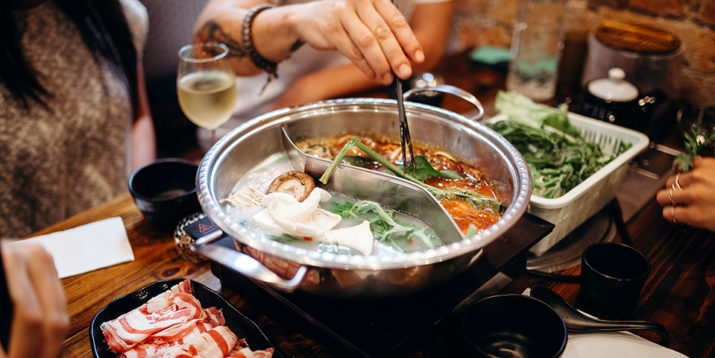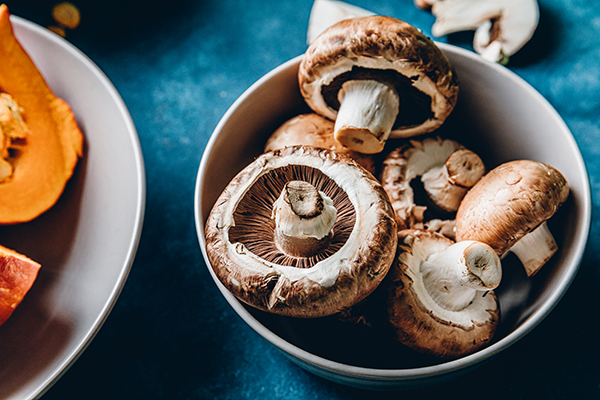Here’s How to Make Hot Pot At Home

A bowl of homemade soup will warm you up on a chilly evening, but if you’re looking for a cozy meal that can feed a whole group — and bring everyone closer together — it’s hard to beat a hot pot recipe.
Ready to have your own hot pot experience?
We’ve detailed everything you need to know about making this versatile, shareable dish.

What Is Hot Pot?
Hot pot is a communal dining experience that involves a metal pot full of simmering broth in the middle of the table, surrounded by a variety of raw meat, seafood, and vegetables waiting to be immersed and cooked.
Hot pot originated in China and is popular throughout Asia.
It’s a versatile meal full of possibilities — there’s no specific hot pot recipe, and the key ingredients can vary widely between regions.
You can put whatever you want in your hot pot and make it as healthy as you want it to be.
The most important element of hot pot is the social experience. Sometimes compared to an Asian version of fondue, hot pot is meant to be shared with a group of friends or family rather than eaten alone.
The History of Hot Pot
Hot pot has been around for more than 1,000 years. It’s believed that the partitioned pots used to make hot pot date back to the Three Kingdoms Era (220 to 280 AD).
There are many different regional versions of hot pots, using different types of broths and meats.
For example, Sichuan hot pots are very popular and use spicy ingredients, while Cantonese hot pot uses a lot of fresh seafood.
What Tools Do You Need For Hot Pot?
Before you head to the grocery store to stock up on ingredients, be sure you have the proper tools to put together your hot pot.
The most important tool is a tabletop burner so you can simmer your broth and cook your food at the table. You can easily find a gas-powered or electric hot pot burner online.
Here are some other tools you’ll need:
- Pot: Look for a divided stainless steel pot, as this is the traditional vessel used for hot pot.
- Chopsticks: Everyone should have at least two pairs of chopsticks — one pair that can be used for transporting raw food into the broth, and one pair that can be used for eating.
- Strainers with handles: Small strainer spoons are necessary for removing cooked food without taking all of the broth with you!
- Extra gas canisters (if using a gas burner): Hot pots aren’t meant to be fast, meaning your burner may run out of gas at least once during the evening. Keep extra canisters on hand so you can start things right back up again.
- Bowls and plates: Small, shallow bowls and plates are necessary, along with spoons for anyone who’s having trouble eating with chopsticks.

6 Essential Hot Pot Ingredients
When it comes to putting together the ideal hot pot, the more food, the better. It’s also fairly easy to make a hot pot healthy.
“A hot pot that contains vegetables, a protein source, a starchy food (like noodles), and other flavor enhancers (that are high in macronutrients and antioxidants) would be an example of a balanced meal,” says Lisa Hugh, M.S.H.S., R.D., L.D.N., CLT, founder and CEO of Single Ingredient Groceries.
1. Broth
The broth is arguably the most important part since you’ll use it to cook the rest of the food.
A divided pot makes it easy to use two different types of broth, and many people like to provide one spicy option and one mild option.
“In order to make a hot pot healthier, select a lower sodium broth,” says Sandy Younan Brikho, M.D.A., R.D.N., of The Dish on Nutrition.
Popular broth options include:
- Chicken broth: Low-sodium chicken broth is a simple and popular way to go.
- Tom Yum: For a big boost of flavor, try this Thai-inspired broth, which is made with lemongrass, chili peppers, fish sauce, galangal, lime juice, and lime leaves.
- Mushroom: Savory mushroom broth can be a good vegetarian option.
- Spicy: The popular Chongqing variety is packed with heat and includes Sichuan peppercorns, red chilies, preserved mustard greens, and more.
2. Vegetables
“Add more vegetables in order to make it healthier!” Younan Brikho says. “This will increase your fiber intake and increase your fullness with minimal calories.”
You can pick any veggies you want. Tomatoes can add lots of flavor, and snap peas can give a nice crunch.
But there are so many great options:
- Leafy greens: Spinach, lettuce, and watercress cook quickly and easily. Heartier greens, like Napa cabbage and bok choy, are great as well and will take longer to cook.
- Mushrooms: Mushrooms add a ton of flavor to your hot pot and are a good vegan and vegetarian add-in. Popular varieties include Shiitake, enoki, button, and portobello.
- Root vegetables: Carrots, daikon radishes, lotus root, and turnips are all great choices. Be sure to cut them into small pieces since they can take a long time to cook.
3. Meat
Meat is a hot pot must-have (unless you’re vegan or vegetarian, of course). Younan Brikho recommends selecting lean cuts of meat or protein to keep things on the healthier side.
Thinly-sliced meat — especially beef, pork, or lamb — is basically a necessity. Paper-thin slices offer the best consistency and cook the fastest.
Chicken is also an option, although it takes longer to cook.
4. Seafood
Seafood is a delicious hot pot ingredient that adds a lot of flavor and cooks pretty quickly. Popular choices include:
- Shellfish: Whole, unpeeled shrimp cooks quickly, tastes delicious, and is usually a crowd-pleaser. Other options include lobster, clams, oysters, mussels, and crab.
- Fish: Thinly-sliced salmon, halibut, monkfish, and bass (among others) will cook quickly and make a great protein source.
- Fish balls or fish cakes: Round fish balls can be made of shrimp, lobster, and cuttlefish, and you can choose homemade ones or pre-made ones that are already cooked and just need to be heated up.
5. Noodles
Noodles should be dropped in at the end when there’s a ton of flavor in the broth, so the starch can pick everything up and taste as delicious as possible.
You can use any type of noodle you like. Common picks include udon, vermicelli, chow mein, and shirataki. For a gluten-free alternative, consider corn, potatoes, or taro.
6. Dips
Condiments are a hot pot essential for two reasons: They make the meal more fun and add a ton of flavor!
“Hot pots tend to include spices, seasonings, and ingredients that might not be consumed in a typical rotation of meals,” Hugh says.
Try using things like soy sauce, sesame oil, peanut sauce, herbs, chili paste or oil, tahini, eggs, and scallions.
You can add some of these directly to the broth or use them as dips for cooked food. Just be sure to use soy sauce and oils in moderation to control sodium and fat intake.
Keep These Hot Pot Rules in Mind
When sharing a hot pot, there are a few proper etiquette tips to keep in mind.
- Keep tabs on your food: Make sure you watch the food you put in and only remove what’s yours. It’s not polite to take someone else’s food out of the hot pot.
- Don’t move food from one type of broth to the other: There are separate broths available for a reason — some people don’t like a spicy broth and only want mild, for example.
- Have fun: Hot pots can be a great social experience. As delicious as the meal may be, don’t forget to keep the focus on the people you’re sharing it with!
